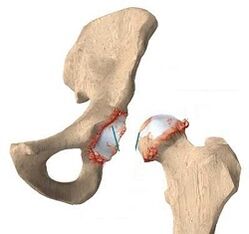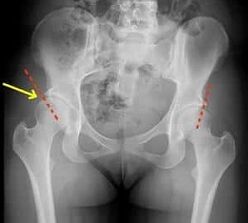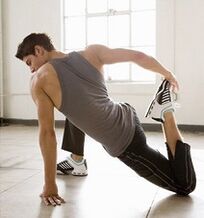It is impossible to imagine a healthy and active lifestyle without being active. Joints are the most important element of the musculoskeletal system, allowing a person to move freely and feel full. With age, dystrophic changes occur in bone and cartilage tissues, appearance of painful sensations, signaling the onset of the disease.
The hip joints can withstand enormous loads throughout life, so it's no surprise that the most common ODA is dry arthritis-hip arthritis. From this article, you will learn what it is, as well as its causes, consequences, and treatments for coxarthrosis.
Characteristics and cause of what happened
Coxarthrosis is a chronic inflammatory process of the hip joint in which cartilage tissue is prematurely destroyed.

The development of the disease stimulates the growth of bone cells and the fusion of the tibia and femoral head, narrowing the joint space, the joint loss of function.
Let's make it clear that coxarthrosis is like degenerative joint and pelvic degenerative joint deformity.
Diseases may arise as a primary pathology or develop on the basis of existing illnesses.
Let's look at the main causes of coxarthrosis:
- during extreme activity or exertion (trauma, minor trauma, overload);
- birth defects (dysplasia, Perthes disease, primary joint deformity);
- pelvic osteoarthritis (ankylosing spondylitis, rheumatoid arthritis or psoriasis);
- severe stress (spasm of blood vessels and muscles, aseptic necrosis, hypothermia);
- hormonal disorders;
- ischemic heart disease;
- endocrine system diseases (obesity, diabetes mellitus).
A complex health problem leads to the development of coxarthrosis disease. Usually, the disease is diagnosed in people of middle age and old age, however, if there are several factors provoking simultaneously, young people and even children are susceptible to coxarthrosis.
Symptoms
In order to respond promptly to the development of pathology, it is important to notice that characteristic symptoms change as joint disease progresses.
The first and most important symptom is pain in the legs, through the groin, glutes, sacrum, thighs, and knees. Pain increases after exertion with time standing and sitting.
Important! At first, the pain may be minor and not appear in the pelvis, but, for example, in the knee. This fact complicates early diagnosis and accurate diagnosis.

If the disease is not detected in time, the patient will face degenerative symptoms such as:
- severe pain in the groin when walking or resting on the legs;
- painful, rattling when moving hips to the side and walking (not to be confused with the click, inherent in most healthy people);
- stiffness, limiting leg mobility;
- changes in gait, limp, duck gait;
- shortens or lengthens limbs;
- muscle atrophy; Fix the
- leg in one position (the ankle).
An important diagnostic sign of coxarthrosis is the physical limitation of leaning forward, shifting hips to one side.
A patient with this diagnosis finds it difficult to tie his own shoelaces, sit with legs wide, and sit deeply.
There are 3 degrees of osteoarthritis of the femur and tip, characterized by gradual joint destruction. Let's take a look at their features below.
Stage 1 of coxarthrosis is characterized by slightly damaged cartilage, slightly narrowed joint space.
By the second stage, the destruction of cartilage tissue increases markedly, the first signs of the disease begin to become disturbed: pain, stiffness.
More severe hip damage occurs in three stages. It is characterized by deep cartilage destruction, bone deformity, pain at rest. The disease completely destroys the meniscus and deformes the femur.
The joint loses mobility, the right leg is fixed and supports. In this case, conservative therapy is impotent, requiring treatment with joint replacement surgery.
Diagnosis
Diagnosis shows the impact level of cartilage and whether degenerative hip disease can cure it.
The success of therapy depends on when treatment is started.
Note. The terminal stage of coxarthrosis does not respond to conservative treatment and requires surgical intervention. Early diagnosis and treatment of the disease will increase your chances of getting well.
For diagnosis, people will examine the outside, evaluate the mobility of the hip joint, change gait and leg length. To confirm primary coxarthrosis, X-rays, CT and MRI are prescribed. If the patient requires surgical treatment, additional urine, stool, blood and joint fluid will be collected.
Treatment of disease

Coxarthrosis is a progressive disease. Can not be treated once such as acute respiratory infections but forget about osteoarthritis.
Successful treatment of grade 1, 2, and 3 degenerative hip osteoarthritis requires a combination of therapeutic exercises, medications, physical therapy, and lifestyle changes of the patient.
In severe cases, surgical treatment of coxarthrosis will be required. Treatment method depends on the severity of the disease.
Medicines
The first thing a patient diagnosed with osteoarthritis is prescribed is a nonsteroidal anti-inflammatory pain reliever. They act directly on the site of inflammation and treat symptoms.
Note! It is important to follow the dosage and duration of the course prescribed by your doctor. Uncontrolled use of NSAIDs will lead to side effects.
For the treatment of coxarthrosis, vasodilators are also prescribed. They are needed to increase blood flow to the diseased joint, and enhance cartilage nutrition.
Chondroprotectors are used to restore cartilage tissue and joint mobility. Glucosamine and chondroitin sulfate are substances that stimulate the production of new building cells and inhibit the activity of enzymes that destroy cartilage tissue.
Massage
Manual therapy or rehabilitation massage is a passive exercise for the affected joints. Thanks to massage movements, blood circulation and lymph drainage are improved, muscles are strengthened, ligaments and tendons become more elastic. This treatment helps relieve pain, improve the effectiveness of drug treatment, and reduce the need for medications.
Important! Massage should only be performed by a qualified professional. Careless movements will make joints hurt and hurt.
Physical therapy exercise
Movement is the basis of life. Exercise for osteoarthritis is aimed at restoring nutrition to cartilage and joint mobility, enhancing corset muscle endurance.
Regular corrective exercise will help reduce discomfort in your legs while walking.
Gymnastics allows you to treat hip pain at home.
All movements are for the treatment and prevention of stages 1 and 2 of degenerative hip disease.
Before starting the exercises, make sure that there are no contraindications to the exercises:
- increased blood pressure;
- important dates;
- infectious diseases;
- increased body temperature;
- postoperative recovery period of abdominal and thoracic organs;
- inguinal and umbilical hernia; Herniated disc
- ;
- acute inflammatory processes of internal organs or exacerbations of chronic diseases;
- Serious diseases of the cardiovascular and circulatory systems.
If, while exercising, some movements cause throbbing pain, chances are, this move is not right for you, so it's better not to do it and exclude it fromcomplex.
Diet

Diet therapy for hip arthritis is aimed at reducing and maintaining a normal weight.
Excess weight puts stress on the spine and joints, increasing the risk of developing musculoskeletal diseases.
The basis of the diet is to eat foods rich in vitamins and minerals in moderation. Food should be whole and contain the necessary building blocks of the cell: proteins, carbohydrates, and fats.
Plant foods should be preferred: nuts, seeds, leafy vegetables, seasonal vegetables and fruits, lean meats and fish, medium-fat dairy products, legumes, and grains.
Ideally cow's milk should be consumed in moderation.
Fatty, spicy, smoked, canned, fried, pickled, semi-finished, alcohol, and coffee foods will have to be excluded from the diet.
Bad habits (smoking, drug addiction, overeating) will also have to be removed from your lifestyle, as they deplete the body, causing premature aging.
How to get rid of pain with folk remedies
Homeopathic therapy for coxarthrosis of the hip joint is one of the alternative treatments. On the basis of natural ingredients, homeopathy produces drugs for the treatment of diseases of the internal organs and of the human skeleton. A special feature of homeopathic preparations for joint disease is that they can restore the balance between cartilage destruction by enzymes and the renewal of its tissues.
Attention! Before treating your hip at home, you need to go through a diagnostic process. It is important not to make the illness worse, as this may impair the person's ability to walk.

Homeopathic remedies, injections and ointments for the treatment of joints are chosen based on the physical conditions of the environment and the location of the disease.
Before taking any medicine, you must consult your doctor!
Precautions
People who are prone to this disease need to avoid stress, injury, treat infectious diseases on time, exercise regularly, eat well, and get enough sleep.
If you experience discomfort in your legs, you should immediately contact an orthopedist for diagnosis and treatment.
Conclusion
Osteoarthritis is most commonly affected in people over 45 years old, athletes, and children with congenital limb disorders. This disease destroys and disfigures the joint, and the patient feels severe pain in the leg. Successful treatment of coxarthrosis requires including therapeutic exercises, medications, adjustments to the patient's lifestyle and weight, and manual therapy.
Health is the key to longevity! Don't delay seeing an orthopedic doctor at the first symptoms of illness.












































